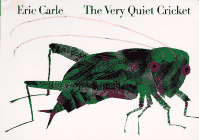The Very Hungry Caterpillar

by Eric Carle. ![]() Picture Book. 32 pages. Grades PreK-1.
Picture Book. 32 pages. Grades PreK-1.
Find this book: Amazon

Review

In this classic picture book first published in 1969, a caterpillar hatches, eats, spins a cocoon, and emerges as a butterfly. Cutouts in the pages make this a three dimensional picture book involving the concept of counting as well as that of metamorphosis. Although the food eaten by the caterpillar is more human than insect fare, the unfolding of the butterfly adds drama to the tale for the very young.
Carle's technique of using layers of tissue paper which he sometimes paints or colors on in effect creates his own paper. This he then cuts out and pastes on a white background. His images are childlike but complex. His technique of cutting holes in the paper of varying sizes which, in later books, is combined with folded pages, besides adding depth and interest to his pages extends our concept of the picture book as being a rectangular, predictable shape.
(Continued Below)
Advertisement:

Activities
- Fact and Fiction. Science: Insects. Writing. Art.:
Which of the things the caterpillar eats would real caterpillars eat? Make a list of things a real caterpillar would eat and make another book like this one only using the things from your list. - Science: Insects:
Look up some pictures of real caterpillars and the butterflies or moths they turn into. Do the prettier caterpillars turn into the prettiest butterflies or moths? Do the ugliest ones do that? - Math: Ordinal Numbers:
Make a list of the things Eric Carle's caterpillar eats. How many things are there? Make that list into sentences that begin with "The first thing the caterpillar ate was . . ." "The second thing the caterpillar ate was . . ." and so on. - Poetry:
Find and read David McCord's poem: "Cocoon." Find other caterpillar poems to share with the class.
(Continued Below)
Advertisement:

Related Books

 Grades K - 2
Grades K - 2
The Very Quiet Cricket by Eric Carle. Picture Book. 32 pages.
Find this book: Local Bookstore, Amazon, B&N
A very small cricket tries again and again to make a chirp by rubbing his wings together as other insects pass him, making their unique sounds. Each page has an insect and a verb describing his behavior. Each page also ends with "The little cricket wanted to answer so he rubbed his wings together, but nothing happened. Not a sound." Read More in our Featured Book Teachers Guide with discussion questions, extension activities, related books and links.
 Grades 2 - 9
Grades 2 - 9
The Art of Eric Carle by Eric Carle. Nonfiction. 128 pages.
Find this book: Local Bookstore, Amazon, B&N
This is a wonderful source book for information about Eric Carle and his work. Carle includes a delightful autobiography amply illustrated with photographs and sketches, but there is much more in the book. An editor relates her experiences with Carle. There's a section about the way he creates his work and writings by Carle and some of his colleagues. Best of all, the book is a compendium of his artwork.
(Continued Below)
Advertisement:

Related Areas Within Carol Hurst's Children's Literature Web Site
- Eric Carle's Featured Author Article with information about the author and his work including a listing of some of his best books.
- Insects and Spiders through Children's Books for Preschool through 9th Grade:
Our Featured Subject Article, a classroom unit with activities across the curriculum and picture books, nonfiction, and novels.

Related Areas Elsewhere on the Internet
Following these links will take you off our web site. You will have to use your back button to return or, bookmark our site now so you can return anytime.
- Eric Carle's Web Site http://www.eric-carle.com/

